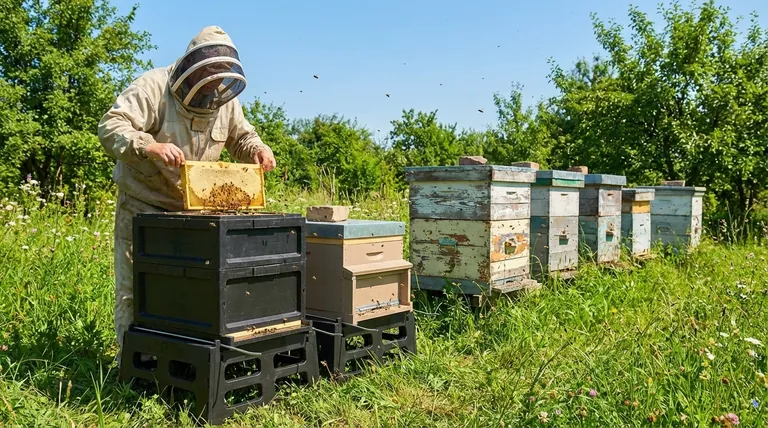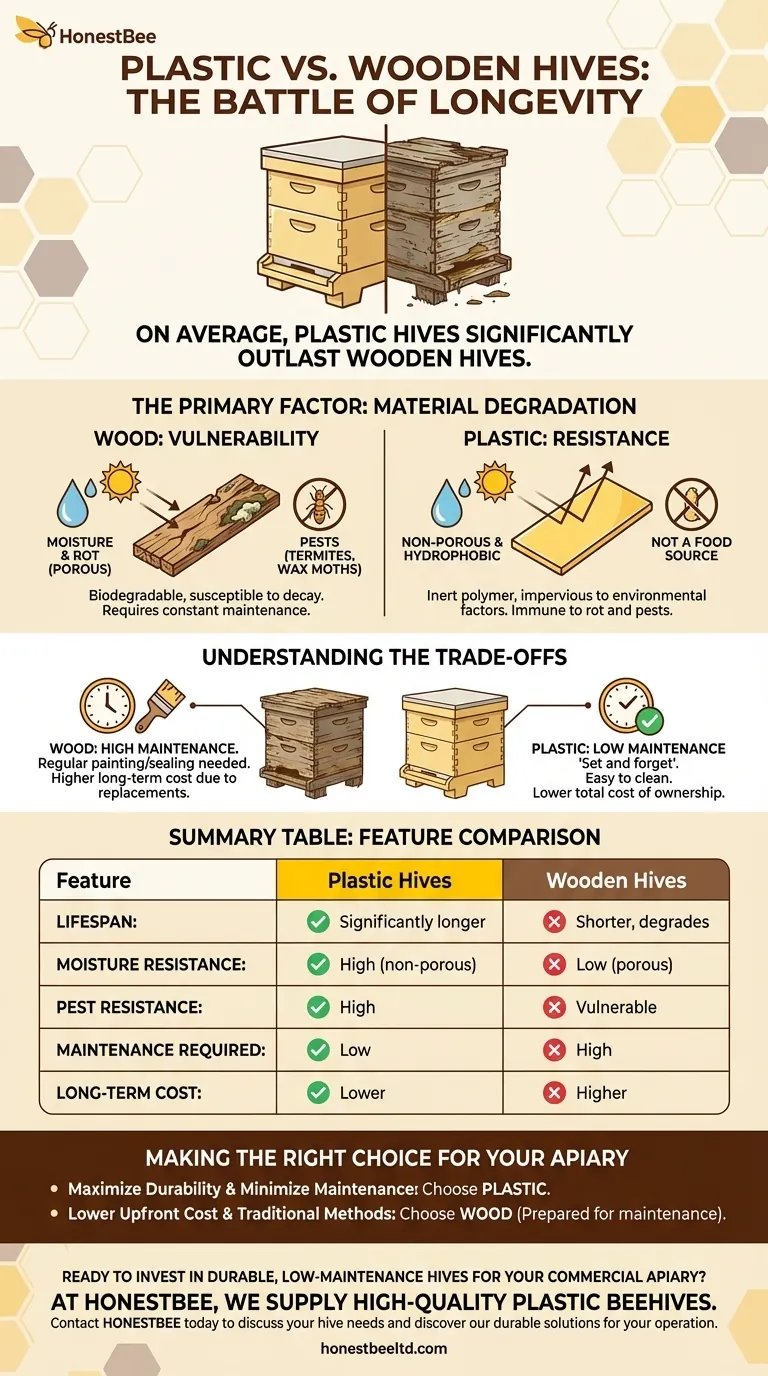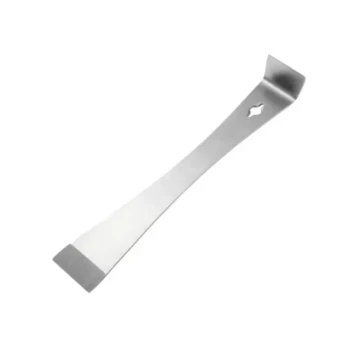On average, plastic bee hives offer a significantly longer lifespan than traditional wooden hives. This extended longevity is due to the inherent properties of the material; plastic is an inert polymer that is impervious to the primary environmental factors, like moisture and pests, that cause wood to deteriorate over time.
The core difference in longevity comes down to one principle: wood is a natural, biodegradable material susceptible to decay, while plastic is a synthetic material engineered to resist it. This makes plastic the more durable option against the constant exposure to outdoor elements.

The Primary Factor: Material Degradation
The environment a beehive lives in is harsh. It's exposed to rain, humidity, sun, and a variety of insects and microorganisms. How the hive material reacts to these pressures directly determines its functional lifespan.
Wood's Vulnerability to Moisture and Rot
A wooden hive's greatest enemy is water. Wood is porous and naturally absorbs moisture from rain and humidity, creating the perfect environment for fungi and bacteria to thrive.
This microbial action leads to rot, which weakens the structural integrity of the hive box, causing joints to fail and wood to become soft and brittle. This process is unavoidable and can only be slowed with diligent maintenance.
Plastic's Resistance to Environmental Factors
Plastic, by contrast, is non-porous and hydrophobic, meaning it does not absorb water. Because moisture cannot penetrate the material, the conditions necessary for rot and fungal growth are never met.
This makes plastic hives immune to the primary cause of degradation seen in wooden hives, allowing them to maintain their structural integrity for many years without special treatment.
The Impact of Pests
Certain pests, like termites or wax moths, can burrow into and damage wooden hive components. Plastic is not a food source for these pests and is generally too hard for them to chew through, offering superior protection against this type of damage.
Understanding the Trade-offs
While plastic offers superior longevity, the choice is not without nuance. The "better" material often depends on your beekeeping philosophy and operational goals.
The Maintenance Demands of Wood
To maximize the lifespan of a wooden hive, consistent maintenance is non-negotiable. This includes painting or sealing the exterior every few years to protect it from moisture and UV rays.
Even with proper care, wooden components will eventually need to be repaired or replaced due to the natural aging process of the material.
The "Set It and Forget It" Nature of Plastic
Plastic hives require virtually no maintenance to preserve their structure. They do not need to be painted and can be easily cleaned with soap and water.
Their durability means less time and money spent on repairs and replacement parts over the life of your apiary. This lower total cost of ownership is a significant advantage for many beekeepers.
Making the Right Choice for Your Apiary
Your decision should be guided by your priorities, whether they are focused on cost, maintenance, or tradition.
- If your primary focus is maximum durability and minimal maintenance: Plastic is the superior choice due to its resistance to rot, moisture, and pests.
- If your primary focus is lower upfront cost and traditional methods: Wood is the classic standard, but be prepared for the ongoing commitment to maintenance required to prolong its life.
Ultimately, choosing a hive material is an investment in the long-term health and efficiency of your beekeeping operation.
Summary Table:
| Feature | Plastic Hives | Wooden Hives |
|---|---|---|
| Lifespan | Significantly longer | Shorter, degrades over time |
| Moisture Resistance | High (non-porous) | Low (porous, prone to rot) |
| Pest Resistance | High (not a food source) | Vulnerable to termites/wax moths |
| Maintenance Required | Low ('set and forget') | High (regular painting/sealing) |
| Long-term Cost | Lower (fewer replacements) | Higher (ongoing upkeep) |
Ready to invest in durable, low-maintenance hives for your commercial apiary?
At HONESTBEE, we supply high-quality plastic beehives and equipment designed for longevity and efficiency. Our wholesale-focused operations provide commercial beekeepers and distributors with reliable gear that reduces long-term costs and maintenance time.
Contact HONESTBEE today to discuss your hive needs and discover how our durable solutions can benefit your operation.
Visual Guide

Related Products
- Plastic Bee Hive Stand for Beekeeping
- Professional Insulated Plastic Bee Hives
- Langstroth Bee Hives Bee Keeping Box for Beginners Beekeeping
- HONESTBEE Professional Long Handled Hive Tool with Precision Cutting Blade
- 7 x Auto Bee Flow Hive Frames Plastic Beekeeping Hive Box Supplies
People Also Ask
- What are the advantages of polystyrene hives for beekeeping? Boost Colony Health & Honey Yields
- Why is it important to level a hive stand properly? Prevent Catastrophic Failure & Ensure Hive Health
- What are the main differences between Langstroth and Top Bar Hive designs? Choose the Right Hive for Your Beekeeping Goals
- What is the purpose of a hive stand in a Langstroth hive? Protect Your Hive and Boost Colony Health
- What are the advantages of a second hive if the queen is killed? The Ultimate Insurance Policy for Your Apiary



















